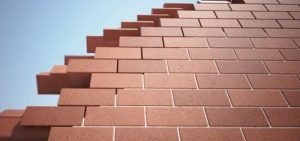What are Interlocking Bricks? its 5 Manufacturing steps, & Benefits
Interlocking bricks are stabilized and compressed earth bricks that provide the strength of the structure, and depending on the supplier, interlocking bricks come in various sizes and locking systems.
Interlocking bricks are usually not subjected to baking and are made by mixing and compressing sand, soil, and cement in a machine, and from stone dust and cement, they can also be made.

The interlocking bricks are different from conventional bricks because the brick does not require mortar during bricklaying work, making the process of building walls faster and requires less skilled labor.
To form a structurally stable wall that reduces the cost and time of construction, these bricks are locked against each other without cement mortar and used to construct Walls.
Manufacturing of Interlocking Bricks:
By mixing cement, sand, and stone dust together in appropriate proportions, these bricks are formed. There are the following steps in the manufacturing process as given below;
- The material which is required for these bricks is batched and mixed proportionately.
- It is then compressed to form bricks with desirable interlocking patterns when the required mix is prepared.
- Then by using a hydraulic compression system, the compression is achieved.
- Then for about 7 days, these bricks are subjected to curing.
- The cement sets and bonds with sand, adding to the stability of the brick once the curing is done.

The soil compression adds strength and density to the brick, and interlocking bricks come in different designs, patterns, and finishes.
Benefits of Interlocking Bricks:
There are the following benefits of these bricks as given below:
Earthquake Resistant:
Various stresses act on the structure during the earthquake, and conventional bricks are not fully equipped to transfer the seismic loads throughout the structure. So, interlocking bricks are effective and proven earthquake-resistant construction materials. Furthermore, to travel seismic forces across the whole structure equivalently, the self-locking pattern of these bricks enables these forces.

No Plaster Work Required:
In conventional wall construction, plastering can be time-consuming and costly and, by using fair-faced bricks of your choice, plastering of walls can be eliminated entirely. In addition, applying a thin layer of paint on these types of bricks results in smooth finishing, and the maintenance cost is minimized.

Provides Cooler Interior:
The compacted bricks commonly result in higher density, which converts itself into high thermal mass, and compacted bricks walls typically furnish warm interiors. So, interlocking bricks provide a much more excellent interior (3 Co – 5 Co) and are less heat-intensive.

Requires Fewer or Unskilled Labors:
For checking the water level, spirit level, and various other operations, skilled labor is required for conventional bricklaying, and unskilled labor may find it challenging to learn the conventional methods. So, interlocking bricks require fewer or unskilled labor for construction.

Minimizes cost:
The cost of buying cement, sand, mortar, and stone dust can be neglected because there is no use of mortar in the construction process of these bricks. Therefore, these bricks result in the overall cost reduction of the construction project because these bricks do not require plasterwork, minor bar bending work, lesser cement, and fewer laborers.
Time Efficient:
For about 21 days, standard conventional bricks have to be cured, where interlocking bricks require only 7 days of curing. Thus, the project can be completed faster by eliminating all the time-consuming tasks.
Disadvantages of Interlocking bricks:
There are the following disadvantages of these bricks such as;
- Rainwater might enter into the lines making it a hostage for insects and other undesired activities.
- The disintegration of the bricks might also occur, especially in the corners, due to the action of the weather.
- If the rainwater enters through the gaps, then the color of the brick changes.
- These bricks are not enough to hold all the forces acting on the structure.
- For a building having more than two stories, these bricks are not suitable.
